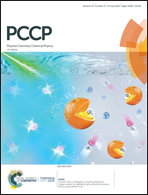Influence of Ti on the dissolution and migration of He in ZrCo based on first principles investigation
Abstract
We have performed state-of-the-art ab initio calculations based on density functional theory to study the effect of Ti on helium dissolution and migration in a dilute Ti-doped ZrCo system. The formation energy of He-related defects predicts that it is preferable to occupy the VZr (Zr vacancy) at first. As for the Heint (interstitial site He), the results corroborate that Hetet (tetrahedral site He) is more stable than Heoct (octahedral site He) by 0.25 eV. The Heoct in the vicinity of Ti atoms becomes unstable, being relaxed into a nearby tetrahedral site, unlike in the pure ZrCo. We also reveal that ZrCo is susceptible to dopant Ti in terms of helium diffusion. The energy barrier for a Hetet to diffuse into a neighboring tetrahedral site is found to be about three times as large as the migration barrier between two adjacent octahedral interstitial sites (0.35 vs. 0.12 eV). In addition, the He atom can migrate from one octahedral site to another without going through a tetrahedral one in pure ZrCo. Furthermore, Hetet needs to overcome higher energy barriers of 0.27 eV and 0.58 eV in Ti-doped ZrCo than in the pure one (0.22 eV and 0.35 eV) along the 1nn (the first nearest neighbor) → 1nn → 2nn (the second nearest neighbor) pathway with the He atom escaping away from the Ti region. In addition, the dissociative energy barrier of the HeZr (Zr position substituted by the He atom) or HeCo (Co position substituted by the He atom) is somewhat higher in the presence of Ti than the pure one. All these conclusions elucidate that Ti acts as a trapping center for He impurities and blocks interstitial He mobility in ZrCo alloys.



 Please wait while we load your content...
Please wait while we load your content...